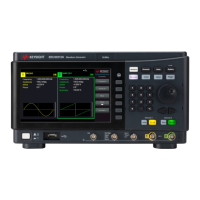signal. Crest factor is the ratio of a signal’s peak value to its RMS value and varies according to waveshape. The table
below shows several common waveforms with their respective crest factors and RMS values.
If an average-reading voltmeter is used to measure the "DC voltage" of a waveform, the reading may not agree with
the DC Offset setting. This is because the waveform may have a non-zero average value that would be added to the
DC Offset.
You may occasionally see AC levels specified in "decibels relative to 1 milliwatt" (dBm). Since dBm represents a
power level, you need to know the signal’s RMS voltage and the load resistance in order to make the calculation.
dBm = 10 x log
10
(P / 0.001) where P = VRMS
2
/ RL
For a sine wave into a 50 Ω load, the following table relates dBm to voltage.
dBm RMS Voltage Peak-to-Peak Voltage
+23.98 dBm 3.54 Vrms 10.00 Vpp
+13.01 dBm 1.00 Vrms 2.828 Vpp
+10.00 dBm 707 mVrms 2.000 Vpp
+6.99 dBm 500 mVrms 1.414 Vpp
3.98 dBm 354 mVrms 1.000 Vpp
0.00 dBm 224 mVrms 6 32 mVpp
-6.99 dBm 100 mVrms 283 mVpp
-10.00 dBm 70.7 mVrms 200 mVpp
-16.02 dBm 35.4 mVrms 100 mVpp
-30.00 dBm 7.07 mVrms 20.0 mVp
-36.02 dBm 3.54 mVrms 10.0 mVpp
-50.00 dBm 0.707 mVrms 2.00 mVpp
-56.02 dBm 0.354 mVrms 1.00 mVpp
For 75 Ω or 600 Ω loads, use the following conversions:
dBm (75 Ω) = dBm (50 Ω) – 1.76
Keysight EDU33210 Series User's Guide
161

